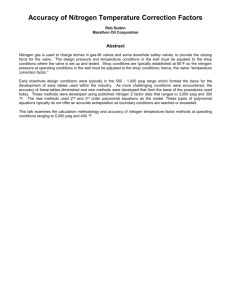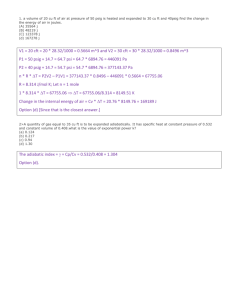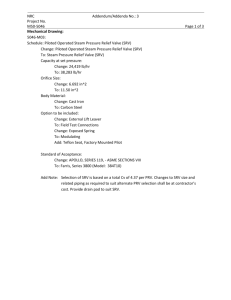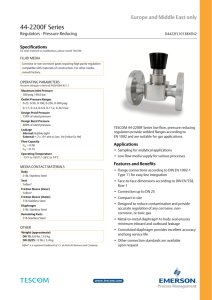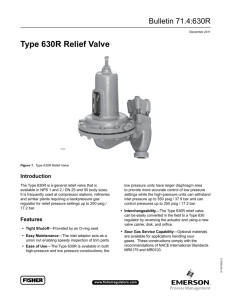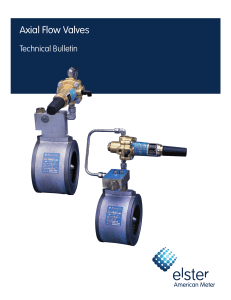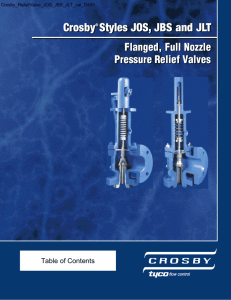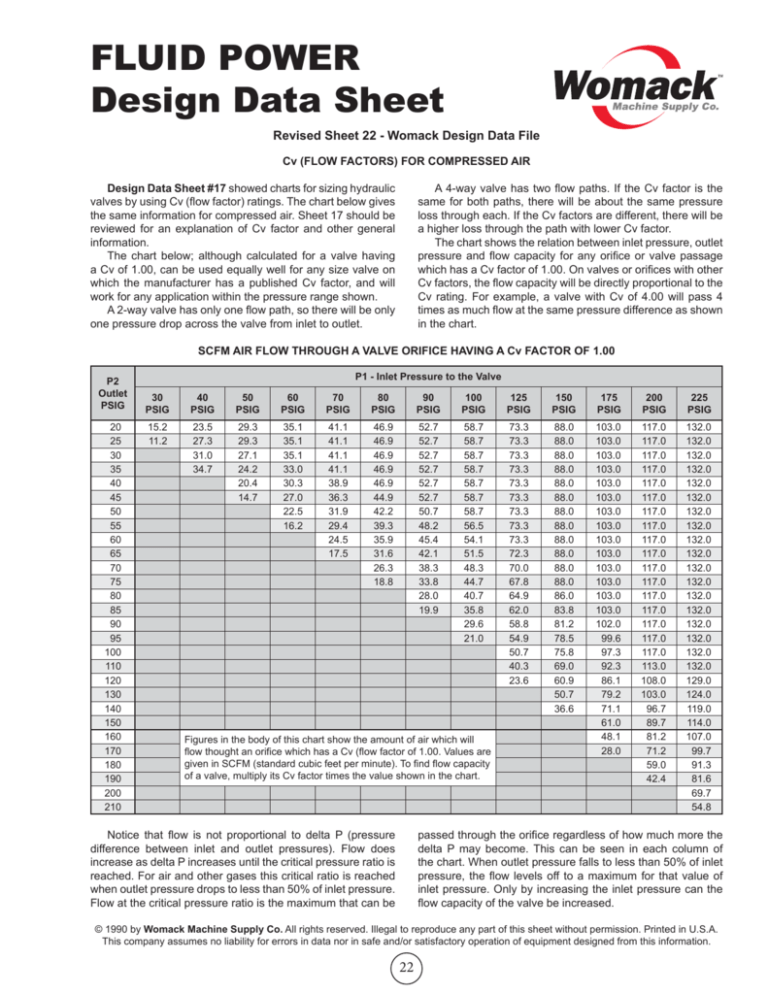
FLUID POWER
Design Data Sheet
Revised Sheet 22 - Womack Design Data File
Cv (FLOW FACTORS) FOR COMPRESSED AIR
Design Data Sheet #17 showed charts for sizing hydraulic
valves by using Cv (flow factor) ratings. The chart below gives
the same information for compressed air. Sheet 17 should be
reviewed for an explanation of Cv factor and other general
information.
The chart below; although calculated for a valve having
a Cv of 1.00, can be used equally well for any size valve on
which the manufacturer has a published Cv factor, and will
work for any application within the pressure range shown.
A 2-way valve has only one flow path, so there will be only
one pressure drop across the valve from inlet to outlet.
A 4-way valve has two flow paths. If the Cv factor is the
same for both paths, there will be about the same pressure
loss through each. If the Cv factors are different, there will be
a higher loss through the path with lower Cv factor.
The chart shows the relation between inlet pressure, outlet
pressure and flow capacity for any orifice or valve passage
which has a Cv factor of 1.00. On valves or orifices with other
Cv factors, the flow capacity will be directly proportional to the
Cv rating. For example, a valve with Cv of 4.00 will pass 4
times as much flow at the same pressure difference as shown
in the chart.
SCFM AIR FLOW THROUGH A VALVE ORIFICE HAVING A Cv FACTOR OF 1.00
P2
Outlet
PSIG
20
25
30
35
40
45
50
55
60
65
70
75
80
85
90
95
100
110
120
130
140
150
160
170
180
190
200
210
P1 - Inlet Pressure to the Valve
30
PSIG
40
PSIG
50
PSIG
60
PSIG
70
PSIG
80
PSIG
90
PSIG
100
PSIG
125
PSIG
150
PSIG
175
PSIG
200
PSIG
225
PSIG
15.2
11.2
23.5
27.3
31.0
34.7
29.3
29.3
27.1
24.2
20.4
14.7
35.1
35.1
35.1
33.0
30.3
27.0
22.5
16.2
41.1
41.1
41.1
41.1
38.9
36.3
31.9
29.4
24.5
17.5
46.9
46.9
46.9
46.9
46.9
44.9
42.2
39.3
35.9
31.6
26.3
18.8
52.7
52.7
52.7
52.7
52.7
52.7
50.7
48.2
45.4
42.1
38.3
33.8
28.0
19.9
58.7
58.7
58.7
58.7
58.7
58.7
58.7
56.5
54.1
51.5
48.3
44.7
40.7
35.8
29.6
21.0
73.3
73.3
73.3
73.3
73.3
73.3
73.3
73.3
73.3
72.3
70.0
67.8
64.9
62.0
58.8
54.9
50.7
40.3
23.6
88.0
88.0
88.0
88.0
88.0
88.0
88.0
88.0
88.0
88.0
88.0
88.0
86.0
83.8
81.2
78.5
75.8
69.0
60.9
50.7
36.6
103.0
103.0
103.0
103.0
103.0
103.0
103.0
103.0
103.0
103.0
103.0
103.0
103.0
103.0
102.0
99.6
97.3
92.3
86.1
79.2
71.1
61.0
48.1
28.0
117.0
117.0
117.0
117.0
117.0
117.0
117.0
117.0
117.0
117.0
117.0
117.0
117.0
117.0
117.0
117.0
117.0
113.0
108.0
103.0
96.7
89.7
81.2
71.2
59.0
42.4
132.0
132.0
132.0
132.0
132.0
132.0
132.0
132.0
132.0
132.0
132.0
132.0
132.0
132.0
132.0
132.0
132.0
132.0
129.0
124.0
119.0
114.0
107.0
99.7
91.3
81.6
69.7
54.8
Figures in the body of this chart show the amount of air which will
flow thought an orifice which has a Cv (flow factor of 1.00. Values are
given in SCFM (standard cubic feet per minute). To find flow capacity
of a valve, multiply its Cv factor times the value shown in the chart.
Notice that flow is not proportional to delta P (pressure
difference between inlet and outlet pressures). Flow does
increase as delta P increases until the critical pressure ratio is
reached. For air and other gases this critical ratio is reached
when outlet pressure drops to less than 50% of inlet pressure.
Flow at the critical pressure ratio is the maximum that can be
passed through the orifice regardless of how much more the
delta P may become. This can be seen in each column of
the chart. When outlet pressure falls to less than 50% of inlet
pressure, the flow levels off to a maximum for that value of
inlet pressure. Only by increasing the inlet pressure can the
flow capacity of the valve be increased.
© 1990 by Womack Machine Supply Co. All rights reserved. Illegal to reproduce any part of this sheet without permission. Printed in U.S.A.
This company assumes no liability for errors in data nor in safe and/or satisfactory operation of equipment designed from this information.
22
Calculating Other Pressure Conditions
Examples of Use of the Chart
The chart was calculated from a formula published by
the Fluid Controls Institute, Inc., 12 Bank St., Summit, NJ
07901, which, when simplified for a Cv of 1.00, compressed
air (specific gravity of 1.00), and an air temperature of 80 to
100°F, reads as follows:
Example: Determine the valve Cv factor necessary to
pass 55 SCFM at only a 5 PSIG pressure loss when valve is
connected to an 80 PSIG air line.
Solution: Look down the 80 PSIG inlet pressure column
and opposite the 75 PSIG outlet pressure line (a 5 PSIG drop
through the valve). The chart, which is based on a Cv of 1.00,
states that 18.8 SCFM will flow. To find necessary Cv for a 55
SCFM flow: 55 ÷ 18.8 = 2.93. Select a valve with at least a 2.
93 Cv and it will meet the flow conditions.
Q = 0.6875 × √P1 - P2 × √P1 - P2 in which:
Q is the air flow in SCFM
P1 is the inlet pressure, PSIG
P2 is the outlet pressure, PSIG
Cv is understood to be 1.00 when using this formula
Other pressure conditions, within the above limitations
can be calculated from the formula. Remember that for outlet
pressures less than 50% of the inlet (below the critical ratio),
use the critical pressure for P2 in the formula. For other gases
and other ambient temperatures, use the original formula as
published by the Fluid Controls Institute.
Example: Suppose a certain valve has a published Cv
factor of 3.75. If this valve is connected to a 125 PSIG air line,
find the pressure loss through it when it is passing a flow of
243 SCFM.
Solution: Since the chart is for a Cv of 1.00, first convert
the 243 SCFM to the equivalent flow expected on a valve having a Cv of 1.00: Equiv. flow = 243 ÷ 3.75 = 64.8 SCFM. Look
down the 125 PSIG column of the chart. The value of 64.9
SCFM opposite the 80 PSIG line comes very close. Since the
chart shows an outlet pressure of 80 PSIG, the pressure loss
through the valve is: 125 - 80 = 45 PSIG.
EXPLOSION PROOF SOLENOID VALVES
Availability of suitable valves may be a problem on air or
hydraulic applications which operate in hazardous locations
and require explosion proof solenoid valves.
For a valve to carry the official underwriters label (UL),
the entire valve assembly, with solenoid operator in place,
must have been submitted to the UL Laboratories for testing
and approval. Each valve size, type, and model must be
separately submitted. Some manufacturers who offer a large
variety of sizes and types do not feel that the high cost of
UL testing on each model is justified by the relatively small
demand for such valves.
Some manufacturers have offered solenoid valves which
they claim are built to UL specifications but which have not
been submitted for approval and do not carry the label. Such
valves may or may not be acceptable in a given situation.
Explosion Proof Operator
4-Way Air or
Hydraulic Valve
Pipe Nipple
Figure 1. Explosion Proof Operator.
Figure 1. Explosion Proof Operator.
Figure 1. Miniature 3-way solenoid valves of the type
pictured are available from several manufacturers with the
official UL label of approval for certain classes and groups
of hazardous service. Most of these valves are built for use
on compressed air. They can be used as pilot operators for
standard 4-way air valves, and for 4-way hydraulic valves which
are equipped with air pilots. The outlet (cylinder) port on the
3-way valve can be connected to the end cap of the 4-way valve
with ordinary piping. Wiring to the 3-way valve coil should follow
all recommendations of the National Electrical Code, or of local
ordinances regarding conduit connections and sealing.
Valves and other electrical components can be
enclosed, when necessary,
in an explosion proof box
which is approved for the
particular type of service.
Electrical and fluid lines
can be brought in through
threaded connections provided in the box. Wiring
and sealing should conform to the National Electrical Code.
Figure 2. Explosion
Figure 2. Explosion
Proof Encloures.
Proof Enclosures.
Hazardous Locations and Atmospheres
First, locations are classified according to the general
nature of the hazard, as follows:
Class I - Highly inflammable gases or vapors.
Class II - Combustible dust.
Class III - Combustible fibers or flyings.
Then, various atmospheric mixtures have been assigned
ratings, Groups A, B, C, D, E, F, and G, according to specific
characteristics such as flash point, explosion pressure,
ignition temperature, etc. It is necessary that equipment be
approved not only for the class of location (I, II, III), but also
for the specific gas, vapor, or dust (group) that will be present.
Example: Class 1, Group D.
For further information refer to the National Electrical
Code. Copies may be purchased from National Fire Protection
Association, 60 Batterymarch St., Boston, MA 02110
Published by:
WOMACK EDUCATIONAL PUBLICATIONS
Womack Machine Supply Co.
13835 Senlac Dr.
Farmers Branch, TX 75234
Tel: 800-859-9801
Fax: 214-630-5314
www.womack-educational.com

